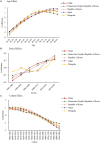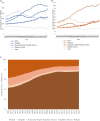Lung Cancer Death Attributable to Long-Term Ambient Particulate Matter (PM2.5) Exposure in East Asian Countries During 1990-2019
- PMID: 34722581
- PMCID: PMC8553966
- DOI: 10.3389/fmed.2021.742076
Lung Cancer Death Attributable to Long-Term Ambient Particulate Matter (PM2.5) Exposure in East Asian Countries During 1990-2019
Abstract
Background: Ambient particulate matter is a public health concern in East Asia as it contributes to a growing number of all-cause and cancer deaths. This study aimed to estimate lung cancer death attributable to ambient particulate matter (PM) < 2.5 μm (PM2.5) in East Asia countries. Methods: The attributable death rates of lung cancer were estimated based on the calculation of population attributable fraction. We performed joinpoint regression analysis and age-period-cohort (APC) model to estimate temporal trends of the attributable death to PM2.5. Results: In 2019, PM2.5 was estimated to have caused 42.2% (nearly 0.13 million) of lung cancer deaths in East Asia men. During 1990-2019, the increase in age-standardized death rates of lung cancer attributable to PM2.5 was highest in China, which increased by 3.50% in males and 3.71% in females. The death rate caused by PM2.5 also significantly increased in the Democratic People's Republic of Korea (2.16% in males; 3.06% in females). Joinpoint analysis showed that the rates generally increased in younger and older people in both the Democratic People's Republic of Korea and Mongolia, while it only increased in elderly people in other countries'. Age effect from APC analysis demonstrated the risk of lung cancer death attributable to PM2.5 generally increased from young to old age. Period effect indicated that from 1994-1998 to 2019-2023 period risk continuously increased by 1.77, 1.68, and 1.72 times in China, the Democratic People's Republic of Korea, and Japan, respectively. The period risk decreased from 1999 to 2009 and subsequently increased from 2009 to 2019 in both the Republic of Korea and Mongolia. Conclusions: The death rate of lung cancer attributable to PM2.5 is increasing in the Democratic People's Republic of Korea, Mongolia, and China. In East Asia, China is facing the highest attributable death rate in recent decades. The period effect suggested a remarkably increased risk of lung cancer death caused by PM2.5 in China, the Democratic People's Republic of Korea, and Japan during the long-term period. It is recommended that the governments of these countries should continuously concentrate on particulate matter pollution governance and improvement.
Keywords: PM2.5; YLL; death; elder; lung cancer; population attributable fraction (PAF).
Copyright © 2021 Liu, Mubarik, Wang, Yu, Wang, Shi, Wen and Yu.
Conflict of interest statement
The authors declare that the research was conducted in the absence of any commercial or financial relationships that could be construed as a potential conflict of interest.
Figures




References
-
- GBD 2017 Risk Factor Collaborators. Global, regional, and national comparative risk assessment of 84 behavioural, environmental and occupational, and metabolic risks or clusters of risks for 195 countries and territories, 1990–2017: a systematic analysis for the Global Burden of Disease Study 2017. Lancet. (2018) 392:1923–94. 10.1016/S0140-6736(18)32225-6 - DOI - PMC - PubMed
-
- Xue T, Zhu T, Zheng YX, Liu J, Li X, Zhang Q. Change in the number of PM2.5-attributed deaths in China from 2000 to 2010: comparison between estimations from census-based epidemiology and pre-established exposure-response functions. Environ Int. (2019) 129:430–7. 10.1016/j.envint.2019.05.067 - DOI - PubMed
LinkOut - more resources
Full Text Sources

